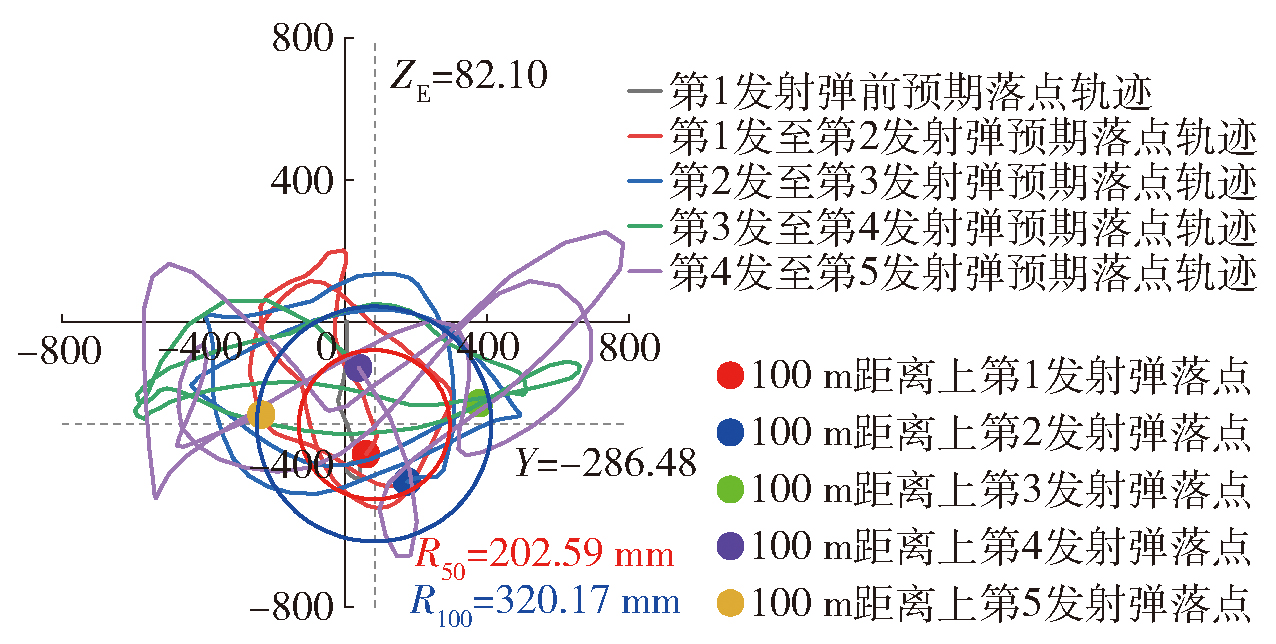


主管单位:中国科学技术协会
主办单位:中国兵工学会
ISSN 1000-1093 CN 11-2176/TJ
主办单位:中国兵工学会
ISSN 1000-1093 CN 11-2176/TJ



兵工学报 ›› 2025, Vol. 46 ›› Issue (10): 250200-.doi: 10.12382/bgxb.2025.0200
收稿日期:2025-03-21
上线日期:2025-11-05
通讯作者:
WANG Yunlong, ZHAO Zhengyuan, WU Zhilin*( ), LI Zhongxin**(
), LI Zhongxin**( )
)
Received:2025-03-21
Online:2025-11-05
摘要: 为提升轻型遥控武器站的精确打击能力与环境适应性,需要对发射载荷作用下武器站的力学特性及射击扰动进行研究,选取某小口径突击步枪为研究对象,在与之匹配的轻型遥控武器站结构基础上,借助ADAMS-Simulink联合仿真,构建了系统的刚柔耦合发射动力学模型,并就单、连发两种工况下系统的射击过程进行了仿真分析;此外,基于仿真结果对遥控武器站装夹模块进行了优化,在武器与装夹结构之间引入了缓冲器,并对优化前后的系统进行了实弹试验验证。结果表明:在单发射击工况下,枪弹发射至电机首次冲击力矩峰值的响应时间在35ms内,且方向电机受冲击更为显著,峰值达182.98N·m; 在连发射击中,残余能量与新一发冲击载荷耦合使电机力矩振荡幅值突增约50%;此外武器自身的射频不稳定性也对射击扰动产生影响。仿真结果与实弹试验结果吻合较好,验证了刚柔耦合发射动力学模型建模的准确性。通过引入缓冲器,可显著降低电机所受冲击力矩和射击扰动,五发连发下的百米半数散布圆半径降低45.8%,显著提升了射击密集度与系统射击精度。
王云龙, 赵正媛, 吴志林, 李忠新. 轻型遥控武器站多工况力学特性及射击扰动[J]. 兵工学报, 2025, 46(10): 250200-.
WANG Yunlong, ZHAO Zhengyuan, WU Zhilin, LI Zhongxin. Mechanical Characteristics and Firing Disturbance of a Lightweight Remote-Controlled Weapon Station Under Multi-Condition Operations[J]. Acta Armamentarii, 2025, 46(10): 250200-.

图3 轻型遥控武器站的刚柔耦合动力学建模与解算步骤示意图
Fig.3 Schematic diagram of rigid flexible coupling dynamic modeling and solution steps for light remote-controlled weapon station

图16 连发射击工况下遥控武器站对100m处目标的打击效果示意图
Fig.16 Schematic diagram of the impact effect of a remote-controlled weapon station on a target at 100m under continuous shooting conditions

图18 添加缓冲器后连发射击工况下遥控武器站对100m处目标的打击效果示意图
Fig.18 Schematic diagram of the impact effect of a remote-controlled weapon station on a target at 100m under continuous shooting conditions after adding a buffer
| 组数 | 刚性连接 | 柔性连接 | 组数 | 刚性连接 | 柔性连接 |
|---|---|---|---|---|---|
| 1 | 476.67 | 216.47 | 7 | 645.24 | 320.10 |
| 2 | 441.41 | 170.07 | 8 | 471.07 | 338.00 |
| 3 | 301.98 | 256.86 | 9 | 381.78 | 163.37 |
| 4 | 465.65 | 228.91 | 10 | 448.87 | 301.99 |
| 5 | 659.59 | 265.24 | 均值 | 458.14 | 248.12 |
| 6 | 289.13 | 220.21 |
表1 射击试验R50统计结果
Table 1 Statistical results of shooting test mm
| 组数 | 刚性连接 | 柔性连接 | 组数 | 刚性连接 | 柔性连接 |
|---|---|---|---|---|---|
| 1 | 476.67 | 216.47 | 7 | 645.24 | 320.10 |
| 2 | 441.41 | 170.07 | 8 | 471.07 | 338.00 |
| 3 | 301.98 | 256.86 | 9 | 381.78 | 163.37 |
| 4 | 465.65 | 228.91 | 10 | 448.87 | 301.99 |
| 5 | 659.59 | 265.24 | 均值 | 458.14 | 248.12 |
| 6 | 289.13 | 220.21 |
| [1] |
|
| [2] |
郑博文, 毛保全, 钟孟春, 等. 智能武器站发展现状与关键技术分析[J]. 火力与指挥控制, 2020, 45(5): 1-7.
|
|
|
|
| [3] |
史婷娜, 谭本慷, 徐奕扬, 等. 机器人关节伺服系统力矩控制技术综述[J/OL]. 中国电机工程学报, 2025: 1-18. [2025-03-08]. https://doi.org/10.13334/j.0258-8013.pcsee.241599.
|
|
|
|
| [4] |
吴永亮, 毛保全, 高玉水, 等. 遥控武器站研究现状与发展[J]. 高技术通讯, 2014, 24(2): 193-200.
|
|
|
|
| [5] |
|
| [6] |
|
| [7] |
|
| [8] |
|
| [9] |
刘强, 周克栋, 宋伟, 等. 某埋头弹机枪退壳系统设计与动力学分析[J]. 北京理工大学学报, 2023, 43(12): 1265-1273.
|
|
|
|
| [10] |
何龙, 姜荃, 李鹏杰, 等. 穿戴武器臂的人枪耦合系统发射响应研究[J]. 北京理工大学学报, 2024, 44(4): 386-394.
|
|
|
|
| [11] |
谢馨, 张连超, 郑杰基, 等. 路面不平度对遥控武器站伺服性能的影响分析[J]. 中国科学:技术科学, 2024, 54(6): 1137-1148.
|
|
|
|
| [12] |
|
| [13] |
|
| [14] |
|
| [15] |
朱锐, 毛保全, 赵俊严, 等. 机枪遥控武器站锰铜基阻尼合金缓冲器非线性有限元分析及试验[J]. 北京理工大学学报, 2022, 42(9): 935-946.
|
|
|
|
| [16] |
陆星宇, 曹岩枫, 庄圆, 等. 四足打击平台多工况力学特性及射击扰动[J]. 工程科学学报, 2024, 46(8): 1434-1445.
|
|
|
|
| [17] |
杨沫, 赫雷, 周克栋, 等. 某专用枪械后坐缓冲装置设计与分析[J]. 哈尔滨工程大学学报, 2025(6): 1-8.
|
|
|
|
| [18] |
冯帅, 毛保全, 王之千, 等. 基于自适应混合近似模型的顶置武器站多柔体系统动力学优化研究[J]. 振动与冲击, 2020, 39(12): 206-212.
|
|
|
|
| [19] |
孙章毅, 蔡灿伟. 动载荷作用下迫击炮与土壤刚柔耦合响应分析[J]. 指挥控制与仿真, 2023, 45(1): 102-107.
|
|
|
|
| [20] |
张雅斌, 刘宁, 黄建文, 等. 迫击炮协调臂前装填系统动力学仿真[J]. 火炮发射与控制学报, 2025, 46(2):83-88,96.
|
|
|
|
| [21] |
华洪良, 廖振强, 郭魂, 等. 机枪系统支撑发射动力学特性及散布精度研究[J]. 兵器装备工程学报, 2022, 43(1): 42-47.
|
|
|
|
| [22] |
曾鑫, 先苏杰, 许德鹏, 等. 某埋头弹机枪自动机结构设计与动力学分析[J]. 兵工自动化, 2021, 40(3): 26-28, 39.
|
|
|
|
| [23] |
张小石, 王宪升, 喻翔, 等. 某自动步枪机构动力学仿真分析[J]. 机械工程与自动化, 2021(4): 64-66,69.
|
|
|
|
| [24] |
欧天界, 贾陆阳, 李东昊, 等. 某导气式自动武器动力学仿真及试验[J]. 兵工自动化, 2024, 43(11): 57-60, 86.
|
|
|
|
| [25] |
吴迪, 顾祖成, 王永娟, 等. 某小型无人化作战平台机电联合仿真[J]. 兵器装备工程学报, 2020, 41(5): 86-90.
|
|
|
|
| [26] |
司鹏, 王云龙, 宋杰, 等. 中口径枪弹全弹道建模及弹道特征量分析[J]. 兵器装备工程学报, 2025, 46(7): 37-43.
|
|
|
| [1] | 刘坤, 冯颖, 康宝, 吴志林, 宋杰, 朱韬. 冲击载荷下四足无人作战平台射击振动特性[J]. 兵工学报, 2025, 46(10): 250282-. |
| [2] | 赵涵, 任会兰, 宁建国. 铝纤维增强铝/聚四氟乙烯活性材料力学性能及反应特性[J]. 兵工学报, 2024, 45(5): 1573-1581. |
| [3] | 梁福文, 苗龙, 田丰, 宋家辉, 白松, 何梓豪, 王宁飞. 摩擦力对空间非导电绳系释放动力学的影响[J]. 兵工学报, 2024, 45(4): 1158-1167. |
| [4] | 刘太素, 尹强, 李勇, 张云添. 链式回转弹仓刚柔耦合动力学建模及特性分析[J]. 兵工学报, 2024, 45(11): 4133-4144. |
| [5] | 慕林栋, 赵鑫磊, 许鹏, 邱天奇, 江磊. 基于力控的助力双轮拖车载荷[J]. 兵工学报, 2023, 44(S2): 61-70. |
| [6] | 杜万闪, 周洲, 拜昱, 张志林, 王科雷. 组合式飞行器多体动力学建模与飞行力学特性[J]. 兵工学报, 2023, 44(8): 2245-2262. |
| [7] | 高普, 李宏才, 刘辉, 孟杰克. 装甲车辆综合传动装置外接油管系统动态特性分析[J]. 兵工学报, 2023, 44(11): 3447-3454. |
| [8] | 葛超, 曲卓君, 王晋, 胡蝶, 王海福. 氟聚物基活性材料动态压剪实验研究[J]. 兵工学报, 2022, 43(8): 1816-1822. |
| [9] | 赵春明, 焦胜海, 王晓飞, 姚跃民, 黄朝东. 柔性充气空间飞行器姿态控制系统设计[J]. 兵工学报, 2022, 43(6): 1346-1354. |
| [10] | 鲁强, 高志峰, 钟小兵, 戴军, 黄秋, 胡绍云. 有限转角钢带的传动特性及预紧张力对输出特性的影响[J]. 兵工学报, 2022, 43(3): 676-685. |
| [11] | 熊漫漫, 闫文敏, 徐诚, 覃彬, 马雪姣. 牛皮模拟靶标的弹道损伤特性[J]. 兵工学报, 2022, 43(1): 29-36. |
| [12] | 李军宁, 王倩, 韩卡, 陈武阁. 坦克炮发射角对炮塔座圈动力学行为及其润滑性能的影响[J]. 兵工学报, 2021, 42(9): 1819-1828. |
| [13] | 张振华, 吴向阳, 李春萍, 张吉智, 魏列江, 王飞. 无人机新型水动力弹射动力学特性[J]. 兵工学报, 2021, 42(1): 151-158. |
| [14] | 王之千, 毛保全, 朱锐, 杨雨迎, 韩小平. 遥控武器站黏弹性胶体缓冲器试验研究[J]. 兵工学报, 2020, 41(2): 209-221. |
| [15] | 计时鸣, 邱文彬, 曾晰, 郗枫飞, 邱磊, 郑倩倩, 石梦. 软固结磨粒群微观力学特性分析与试验研究[J]. 兵工学报, 2019, 40(5): 1068-1076. |
| 阅读次数 | ||||||
|
全文 |
|
|||||
|
摘要 |
|
|||||
 京公网安备11010802024360号 京ICP备05059581号-4
京公网安备11010802024360号 京ICP备05059581号-4